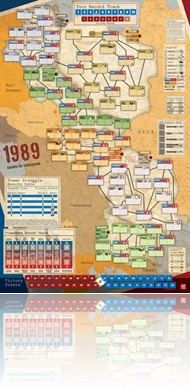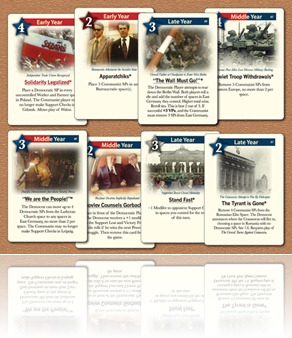![1989cover[1] 1989cover[1]](https://www.gmsmagazine.com/wp-content/uploads/1989cover1.jpg) 1989: Dawn of Freedom from GMT Games
1989: Dawn of Freedom from GMT Games
By Mark Rivera from Boardgames in Blighty
Designers – Jason Matthews, Ted Torgerson
Art – Donel Hegarty, Rodger B. MacGowan, Leland Myrick, Mark Simonitch
GMT games provided a copy of this game for review purposes
Twilight Struggle… I’ve never played it, but I’ve read enough and spoken to other gamers to know you can say no more as GMT’s giant of a game about the Cold War set the bar very high in terms of card driven war games. So what next? Well, a new take on the Twilight Struggle system is available in 1989: Dawn of Freedom, a 2- player game for ages 12+ (I would recommend 14+) focusing on the collapse of Communism in Eastern Europe and the Balkans.
I was very interested to try this game out, having watched the events on the news when they all happened. It was quite a time, I must say.
Unboxing
This game maintains and delivers the high standards of production that you would be used to if you have previously played a GMT game.
You get –
- 2 countersheets with mostly the SP counters and other markers
- Rules booklet
- 22″ x 34″ map depicting Eastern Europe and the Balkans
- 2 player aid cards
- 110 strategy cards
- 52 Power struggle cards
- 2D6
 The quality of all of the components is first class and a pleasure to use in the game. The size of some of the print on the cards is a bit small but readable.
The quality of all of the components is first class and a pleasure to use in the game. The size of some of the print on the cards is a bit small but readable.
The map shows the different countries and the boxes representing all of the cities where the fight for control takes place. It’s gorgeous!
The cards are sturdy and will survive much shuffling. There are three decks covering the Early, Middle and Late parts of 1989 and a Power Struggle Deck. The images depict many of the events of the time and give a strong sense of the struggle. Fascinating stuff and a joy for history buffs. Some of the events favor the Communists, some the West. The rules are laid out pretty well and there are example illustrations as well as more information regarding the historical events represented by the Event cards. Excellent!
Gameplay
1989: Dawn of Freedom, is not an entry-level game and may overwhelm new gamers but if you play with an experienced gamer, you will quickly be able to get into the flow of the game. Your first play, in particular will be a bit slower and I’d say that you need to set aside 3 hours minimum but its a very absorbing time as you will find yourself reading the cards to gain an understanding of the historical events. So its on the one hand, a game and on the other a history lesson.
The process is involved, but after a couple of turns, it is reasonably easy to follow. The key to understanding the gameplay is the Event Deck. It is really the heart and soul of the game.
From the rules:
In 1989: Dawn of Freedom, the players will recreate the momentous revolutions of 1989. One player is the Communist. He will need to use a wise combination of crackdowns, concessions, and reforms to try to hold onto power. The other player is the Democrat. He will try to use the leadership of intellectuals and the street protests of the students to generate a critical mass of opposition to the regimes in order to launch a revolution. Both players will try to swing the workers to their side. At the start of the game, the Communist holds power in each country. The Democrat will attempt to topple the Communist from power through the resolution of scoring cards. The longer the Communist holds power in a country, the more points he scores. The player most successful in advancing his cause wins the game.
The players set out their starting Support points in various locations (its all about support points) and prepare the 3 Strategy decks (early. middle and late year).
The turn sequence –
- Deal strategy cards – each turn, players draw strategy cards up to a hand of 8 cards – You start with the Early year cards and as the game goes on you will add the Middle and Late year cards
- Play Action Rounds – each player takes an action which comes from playing a card’s event which could be beneficial to either side, or using the value of the card to place support points (operations).
- You will usually have 1 extra card to choose from each turn. Just make sure you do play any scoring cards or you will lose. The asterisked Event cards do go out of the game if the event takes place.
- There are some interesting choices and some tough choices to make as you will be playing cards for ops points that your opponent will benefit from the event.
- Placing Support points is very important and you will need to consider where and when to place your SP’s. You will want to place enough to take control of certain locations before your opponent does but its a tricky balance as you can’t be everywhere and spreading yourself too thin may backfire. Early in the game, the advantage is with the Communist player and they will have more opportunities to build up strength however the momentum will shift and if countries come under Democrat control early, the Communist player will be up against it for sure.
- You can also play 1 card per turn on the Tienanmen Square Attempt table. This is a good way to use a card that would normally benefit your opponent, delaying the opportunity for the benefit to take place until the card is recycled later.
- Various event cards will also give victory points
- When Scoring cards are played, a Power Struggle takes place resulting in one of the players having control of a country. The Power Struggle is a separate mechanic using the Power Struggle cards, comparing cards played first as attacker and then possibly as defender, basically to see if you can outwit your opponent by playing a card they can’t match. For me, this is the clunkiest part of they game and slows things down too much. I would have preferred this to be simplified using a table with die rolls and modifiers. I think it would have kept things moving better. I find the use of the cards adds an unneeded layer of complexity and time.
3. Make extra support checks (if applicable) – these are used to try and reduce the support available in a country for either side
 4. Verify held cards – Very important! You must play country scoring cards in your hand on the turn they are drawn or you automatically lose! Playing these cards will determine how much power is available to each player and who takes control of the country.
4. Verify held cards – Very important! You must play country scoring cards in your hand on the turn they are drawn or you automatically lose! Playing these cards will determine how much power is available to each player and who takes control of the country.
5. Celebrate New Year’s Eve Party (if applicable) triggers the game end
6. Advance turn marker
7. Calculate final scoring (after turn 10)
Victory Conditions
- Automatic Victory
takes place if a player reaches 20 victory points or if a player is holding an unplayed score card at the end of a turn - If the New Year’s Eve Party card is played, this triggers the end game and a final Power Struggle takes place and the player in the lead wins
- If neither side has achieved the above, then Final country scoring takes place with the leading player winning
Did it work for me?
To me a mark of a superior game, at least for me anyway, is that I become even more curious about it and I keep thinking about it. 1989: Dawn of Freedom does this for me in abundance. This is a game that gives the players a very rich experience. At first glance, it almost seems like the mechanics dominate, but as you start to see the story unfold, it really brings the game alive and the pressure and tightrope walking impacts both players. There’s loads of historical information on the cards and in the rulebook and its fascinating, riveting stuff. It brought back my remembrance of following events on the news.
I found that the game process was relatively comfortable although it took me a while for it to click as to where I needed to focus my SP build up. After a few turns I felt pretty comfortable. Having said that, I found the Power Struggle process a bit laborious and it felt like it could have been simplified. going through the Power Struggle cards and selecting which to play almost felt a bit like an unnecessary game within a game and stalled the momentum of the strategic picture too much. If this had been simpler, maybe a die roll against a Power Struggle table, would have worked better and made the whole turn more streamlined. It’s not a major problem really but I would it to have been done differently.
Having said this, I still wholeheartedly give 1989: Dawn of Freedom a huge thumbs up. And I say this, never having played Twilight Struggle which I am now looking forward to very much. The strategic scope, the war-game-like feel where you are playing Power Politics is very compelling and successfully gives you a real feeling for the situation. I would certainly think that Twilight Struggle fans would enjoy this game.
Can’t wait to play it again!
Boardgames in Blighty Rating – 8 out of 10
Family friendly?
This is not a family game
